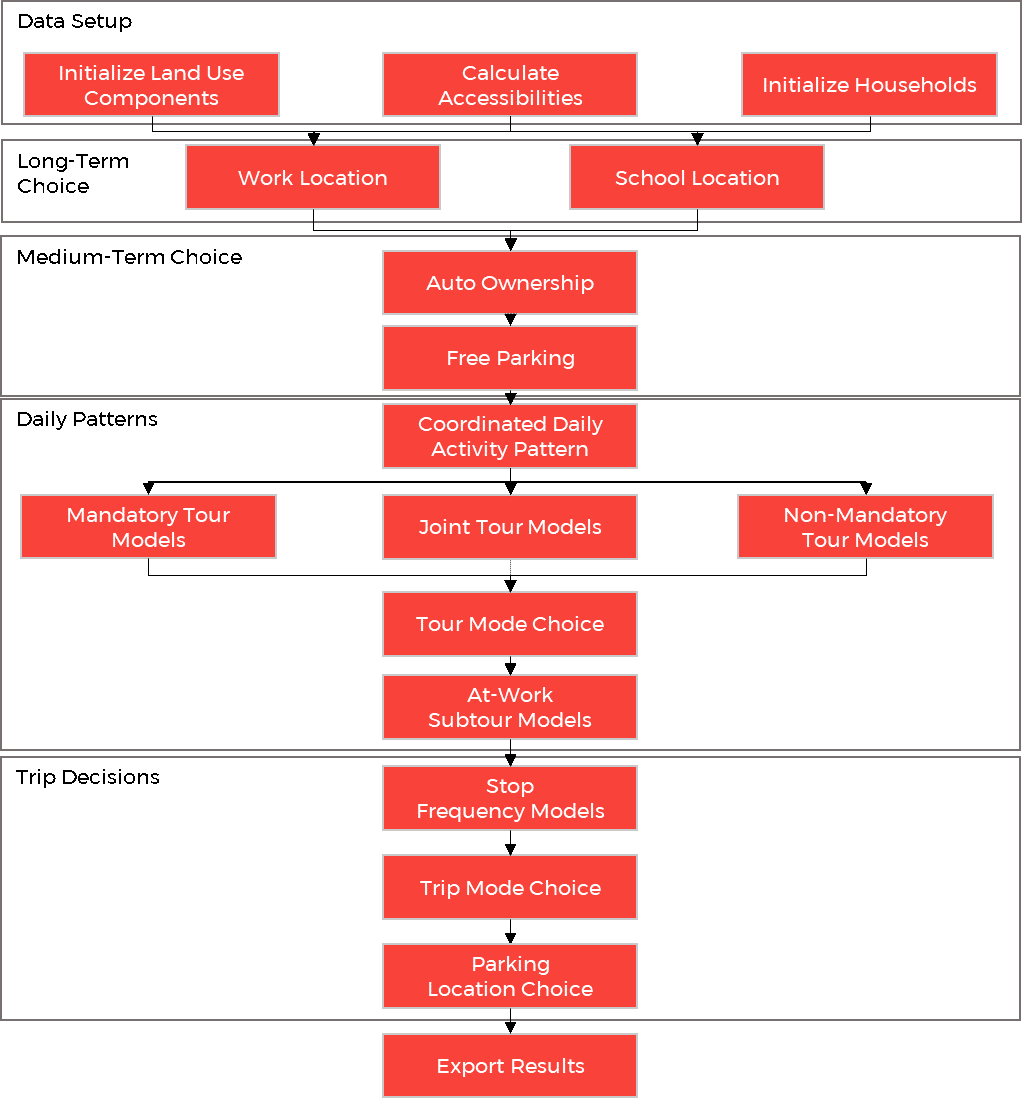This page highlights real-world implementations of the ActivitySim model around the world. To share your story with the ActivitySim community, contact us!
ActivitySim in the World
San Diego Association of Governments
The San Diego Association of Governments (SANDAG) is readying its ActivitySim-based model for the MPO’s next long-range plan update. The move to ActivitySim allows SANDAG to enhance its travel model with additional choice models, such as vehicle type and transit pass ownership. This means a model that better estimates emissions and also can respond to actual or proposed policy changes, such as subsidized transit passes. The new model is called ABM3, for activity-based model. As part of the update, SANDAG has re-estimated several choice models with local survey data using ActivitySim’s estimation mode. The update also extended ActivitySim codebase in collaboration with BayArea MTC. (Find more on the code at this GitHub site.) This branch will be merged into main ActivitySim branch. They are currently wrapping up calibration & validation and have begun sensitivity testing of ABM3.


Atlanta Regional Commission
ARC began a prototype implementation of ActivitySim for the Atlanta region a few years ago. This plan provided a path to implementing, prototyping, and testing the ActivitySim framework at ARC. ARC is able to take advantage of the ActivitySim “One Build – Many Deployments” philosophy, which means that the ActivitySim code base is designed to be geographically agnostic until implemented through configuration files. Thus, each region that adopts ActivitySim will benefit from improvements made in other regions with minimal effort.
For ARC-specific model implementation, the agency established its own ActivitySim repository on GitHub. Following the ideal of “One Build – Many Deployments,” ARC has little to no customized model components stored in its repository. All software documentation are kept in the project GitHub repository along with the YAML and CSV configuration files.
ARC implemented each model component in the ActivitySim workflow sequentially. This includes fully developing, calibrating, and testing before moving onto the next model in the ActivitySim workflow. This ensures that ARC works through the model flow in a way where each model component is calibrated and tested based on the calibrated outputs of upstream components and the existing ARC CT-RAMP ABM implementation. This gets repeated for each model component sequentially until the model system is complete. The figure to the left illustrates a simplified version of the ARC CT-RAMP to ActivitySim transitional workflow.
For more information, contact Guy Rousseau, Travel Surveys and Transportation Model Development & Applications Manager.
MWCOG (Washington, D.C., region)
When the Metropolitan Washington Council of Governments (MWCOG) began developing its next-generation travel demand model in 2018, they began with ActivitySim. Their goal is creating a simplified activity-based travel model (ABM), known as the Gen3 Model. The benefit of moving to an ABM is expected to be the new modeling capabilities that the Gen3 Model should provide, such as performing equity analyses and estimating the likely travel response to transportation pricing policies.
MWCOG has divided this project into three phases. The goal of Phase 1 was to estimate and calibrate some of the submodels that make up ActivitySim, and thus, the Gen3 Model, and to develop a prototype model that could be used by staff for testing. Phase 1 was completed in 2023, with documentation available here. The goal of Phase 2 – which should be completed in the first quarter of 2024 – is to perform further model estimation and calibration, and to develop a travel model that could be used for production modeling work in the region.
The Gen3, Phase 2 Model is now meeting or exceeding the validation metrics of the previous Gen2 Model, and version 1.0 of the Gen3 Model has been submitted to staff for review. Phase 3 will consist of usability testing, conducted by MWCOG staff, which is designed to ensure that the model is ready for production use. Once the Gen3 Model has been deemed ready for use, staff will provide training on the new model to the metropolitan Washington modeling community and will begin using the model in production work, for studies such as scenario studies and air quality conformity analyses.


State of Oregon
As of early 2024, the Oregon Modeling Statewide Collaborative (OMSC) is moving forward on a statewide joint ActivitySim estimation across all eight MPOs in Oregon that use State of Oregon resources for modeling support. (Two of the 10 MPOs within Oregon are supported by Washington State.)
This joint estimation will be based on the 2023-2024 Oregon Statewide travel survey, and will build on the “BayDAG” ActivitySim model implementation.
The final design for the OMSC’s joint estimation approach should be finalized by April 2024. As the OMSC moves into estimation and putting ActivitySim to use, the code will be stored here.
As Oregon’s project progresses, the content here will be updated with more current resources and information.